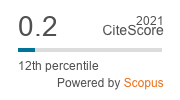Variables predictoras de riesgo de cáncer de pulmón en fumadores
Resumen
Objetivo: Determinar los parámetros de eficiencia y la relación entre variables predictoras del riesgo de ser diagnosticadas con cáncer de pulmón en personas fumadoras.
Métodos: Estudio analítico tipo casos y controles. Casos: 55 pacientes, controles: 115 individuos. Variable resultado: riesgo de ser diagnosticado con cáncer de pulmón. Variables predictoras: edad, sexo, tiempo fumando, color de la piel, número de cigarrillos al día, paquetes/años, antecedentes familiares de cáncer de pulmón, antecedentes familiares de cánceres relacionados con el tabaquismo distintos del cáncer de pulmón, tiempo de abstinencia al tabaco, edad de iniciación en el hábito. Método estadístico: regresión logística multivariada.
Resultados: Las variables que mayores odds ratio mostraron: efecto acumulativo del tabaquismo de más de 30 paquetes por año (OR= 8,5; IC 95 % 3- 23); antecedentes familiares de cáncer de pulmón en parientes de primer grado (OR= 6,5; IC 95 % 4,6- 7,0) y el color de piel negra (OR= 6,3; IC 95 % 3,2- 12,7).
Conclusiones: Las variables que mayor relación mostraron con el riesgo de cáncer de pulmón fueron: color de piel negra, tiempo fumando mayor de 35 años, consumo de más de 30 paquetes por año, y antecedente familiar de cánceres relacionados con el tabaquismo en órganos distintos del pulmón.
Referencias
Ferlay J, Soerjomataram I, Dikshit R, Eser S, Mathers C, Rebelo M, ParkinDM, Forman D, Bray F. Cancer incidence and mortality worldwide: sources, methods and major patterns in GLOBOCAN 2012. Int J Cancer. 2015[cited 2017 Feb 5];136(5):359-86. Available from: https://onlinelibrary.wiley.com/doi/full/10.1002/ijc.29210
Jemal A, Bray F, Center MM, Ferlay J, Ward E, Forman D. Global cancer statistics. CA Cancer J Clin. 2011 April;61:69-90.
Torre L A, Siegel R L,Ward E M, and Jemal A. Global Cancer Incidence and Mortality Rates and Trends-An Update. Cancer Epidemiol Biomarkers Prev. [Internet]. 2016 Jan [cited 2017 Feb 5]; 25(1): 32-45. Available from: http://cebp.aacrjournals.org/content/25/1/16.long
Siegel R, Miller KD, Jemal A. Cancer statistics, 2017. CA Cancer J Clin 2017;67(1):7-30.
Dirección nacional de registros médicos y estadísticas de salud. Anuario Estadístico de Salud. Ministerio de Salud Pública. La Habana; abril 2016 [citado 16 nov 2016]. Disponible en: http://files.sld.cu/bvscuba/files/2016/05/anuario-2015-e.pdf
Bergen AW, Javitz HS, Krasnow R. Nicotinic acetylcholine receptor variation and response to smoking cessation therapies. Pharmacogenet. Genomics. 2013;23(2):94-103.
Gray PE, Teare MD, Stevens J, Archer R. Risk Prediction Models for Lung Cancer: A Systematic Review. Clin Lung Can. 2016;17(2):95-106.
Powell HA, Iyen-Omofoman B, Hubbard RB, Baldwin DR, Tata LJ. The association between smoking quantity and lung cancer in men and women. Chest. 2013;143:123-9.
Kiyohara C, Ohno Y. Sex differences in lung cancer susceptibility: a review. Gend Med. [Internet] 2010 [cited 2017 Apr 12];7(5):381-401. Available form: https://www.ncbi.nlm.nih.gov/pubmed/21056866
Vavalá T, Mariniello A, Reale ML, Novello S. Gender differences in lung cancer. Ital J Gender-Specific Med 2016;2(3):99-109.
Risch HA, Howe GR, Jain M, Burch JD, Holowaty EJ, Miller AB. Are female smokers at higher risk for lung cancer than male smokers? A case-control analysis by histologic type. Am J Epidemiol. 1993;138:281-93.
Malvezzi M, Bertuccio P, Rosso T, Rota M, Levi F, Vecchia C La, et al. European cancer mortality predictions for the year 2015 : does lung cancer have the highest death rate in EU women ? Ann Oncol [Internet]. 2015 [cited 2017 Feb 5]; 26(4):779-86. Avaiable from: https://www.ncbi.nlm.nih.gov/pubmed/25623049
North CM, Christiani DC. Women and Lung Cancer: What's New? Semin Thorac Cardiovasc Surg. 2014;25(2):1-13.
Pirie K, Peto R, Reeves GK, Green J, Beral V. The 21st century hazards of smoking and benefits of stopping: a prospective study of one million women in the UK. Lancet. 2013;381:133-41.
Young RP, Hopkins RJ, Whittington CF, Hay BA, Epton MJ, Gamble GD. Individual and cumulative effects of GWAS susceptibility loci in lung cancer: associations after sub-phenotyping for COPD. PLoS One. 2011;6(2):222-35.
Irwin RS. Are COPD and Lung Cancer Two Manifestations of the Same Disease? CHEST. 2005;128(4):1895-7.
Ruyi H, Yongyue W, Rayjean J H, Geoffrey L, Li S, Ruyang Z, et al. Associated Links Among Smoking, Chronic Obstructive Pulmonary Disease, and Small Cell Lung Cancer: A Pooled Analysis in the International Lung Cancer Consortium. EBioMedicine 2015;8(4):1677-85.
Hall FS. Genetic Risk for Lung Cancer and the Benefits of Quitting Smoking. EBioMedicine. 2016;(11):19-20.
Gatenby RA, Brown J. Mutations, evolution and the central role of a self-defined fitness function in the initiation and progression of cancer. Biochim Biophys Acta [Internet]. 2017 [cited 2017 Sep 16];1867(2):162-6. Available from: https://www.ncbi.nlm.nih.gov/pubmed/28341421
Mong C, Garon EB, Fuller C, Mahtabifard A, Mirocha J, Mosenifar Z, et al. High prevalence of lung cancer in a surgical cohort of lung cancer patients a decade after smoking cessation. Jour Card Surg. 2011;6(19):1-7.
Peter B B, Michael W K, Mark D Th, Mark G K, Ramsey C T, Matt J B, et al. Variations in Lung Cancer Risk Among Smokers. Jour Nat Can Inst. 2003;95(3):470-8.
Fangyi Gu, Sholom Wacholder, Stephanie Kovalchik, Orestis A. Panagiotou, Carolyn Reyes-Guzman, Neal D. Freedman, et al. Time to Smoke First Morning Cigarette and Lung Cancer in a Case-Control Study. J Natl Cancer Inst. 2014;107(6):1-8.
Gaelle Coureau, Rachid Salmi L, Cécile Etard, Sancho-Garnier H, Sauvaget C, Mathoulin-Pélissier S. Low-dose computed tomography screening for lung cancer in populations highly esposed to tobacco: A systematic methological appraisal of published randomized controlled trials. Euro J Cancer. 2016;81(4511):146-56.
Carol J E, Sumesh K, Mei L, D'Amelio A, Qiong D, Cote ML. Development and Validation of a Lung Cancer Risk Prediction Model for African-Americans. Cancer Prev Res 2008;1(4):255-65.
Chen L.-S, Baker T, Hung RJ, Horton A, Culverhause R, Hartz S, et al. Genetic risk can be decreased: quitting smoking decreases and delays lung cancer for smokers with high and low CHRNA5 risk genotypes - a meta-analysis. EBioMedicine. 2016;11(6):219-26.
du Prel J-B, Roling B, Blettner M. Statistical Methods in Medical Research. Dtsch Arztebl Int. 2009;106(7):99-127.
Enlaces refback
- No hay ningún enlace refback.
URL de la licencia: http://creativecommons.org/licenses/by-nc-sa/3.0/





 La revista es de acceso abierto y gratuito.
La revista es de acceso abierto y gratuito.